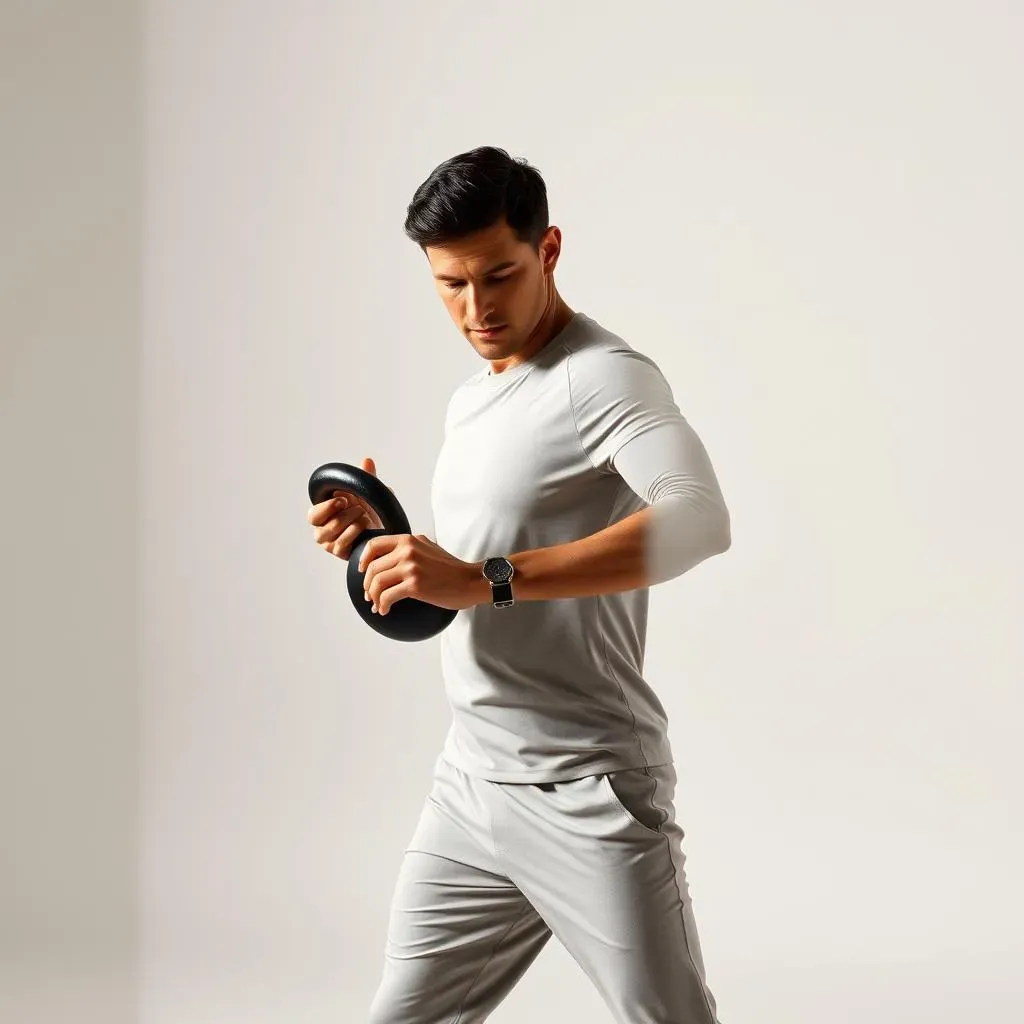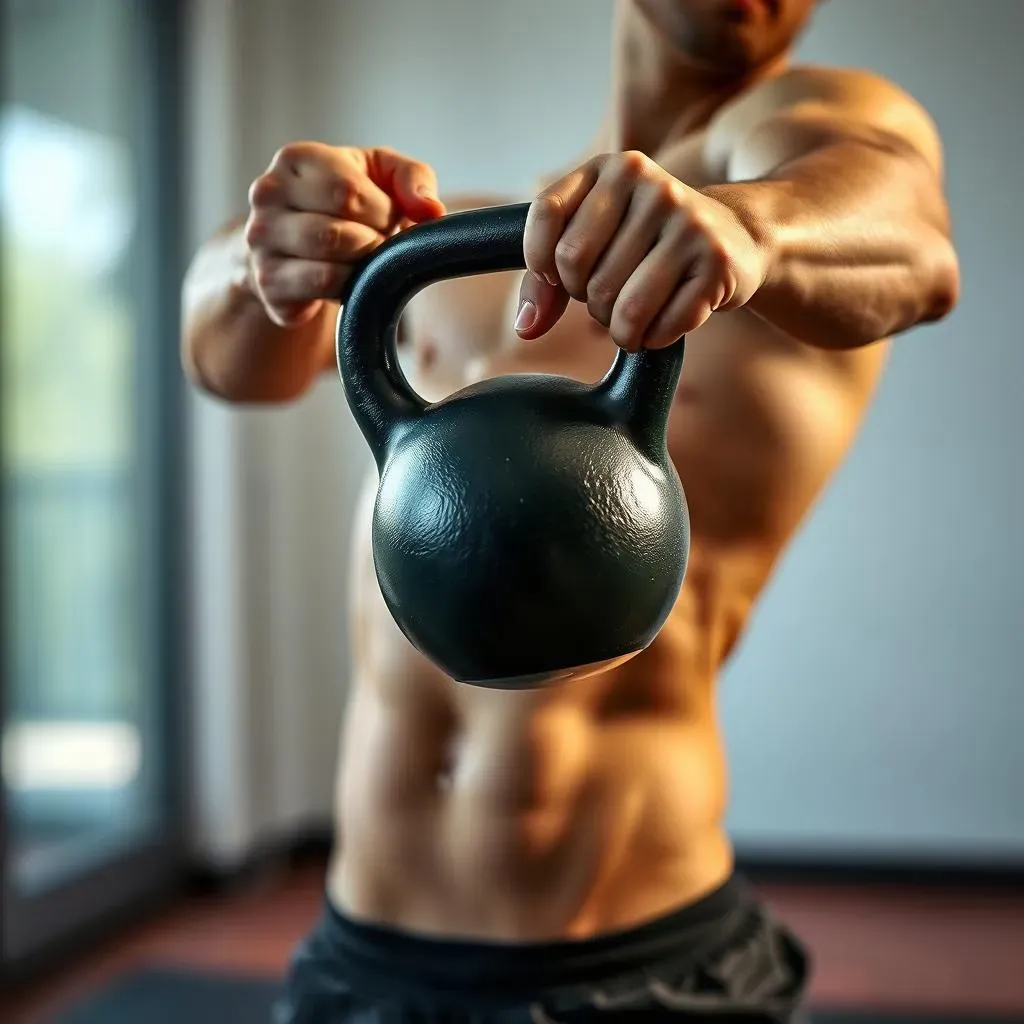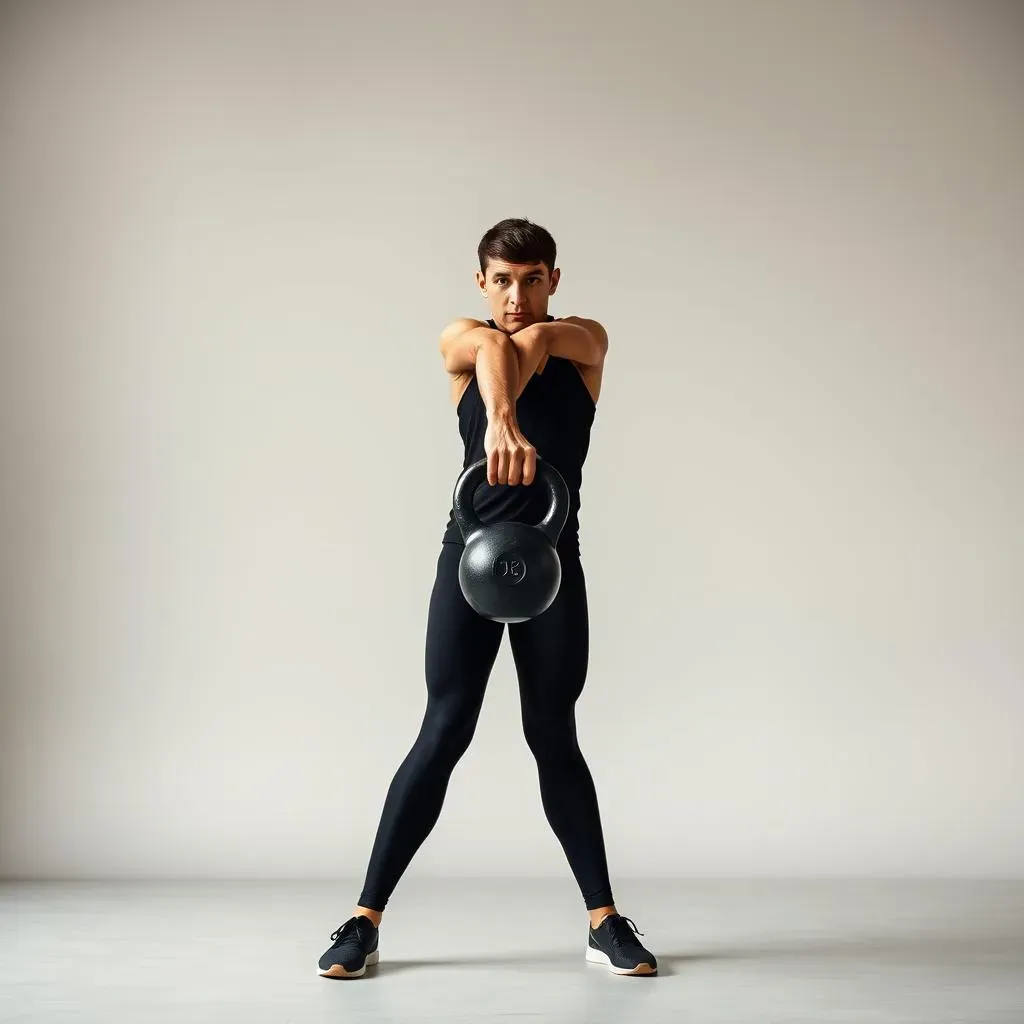Table of Contents
Tired of the same old crunches and sit-ups? Me too! Let's face it, ab workouts can get boring fast. But what if I told you there’s a way to spice things up, work your core like never before, and actually have some fun? Enter the kettlebell ab exercise 'around the world'. This isn't your typical ab move; it's a dynamic, full-body exercise that will challenge your balance, coordination, and strength. In this article, we'll break down exactly how to perform the kettlebell around the world, share some crucial tips from trainers, highlight the amazing benefits you can expect, and, of course, point out common errors to dodge. Plus, we'll explore some killer alternatives if you're not quite ready to go 'around the world' just yet. Ready to transform your core workouts? Let's get started!
How To Do the Kettlebell Around the World

How To Do the Kettlebell Around the World
The Starting Stance
Okay, so you want to learn this awesome move? First, grab a kettlebell that feels comfortable, not too heavy. Stand with your feet about shoulder-width apart, like you're getting ready to do a squat. Hold the kettlebell in one hand, letting it hang down in front of you. Now, stand tall, engage your core—imagine someone is about to poke you in the stomach—and get ready to move.
Think of this like a dance, not a struggle. With the kettlebell hanging in front of you, start moving it in a circle around your body. As the kettlebell swings, transfer it from one hand to the other behind your back and in front of your body. It should feel like you are tracing a big circle with the kettlebell. Keep your arms as straight as possible throughout the movement, and try to keep your torso from twisting too much. The movement is smooth and controlled, not jerky.
The Circular Motion
Now, let's talk about that circle. The key is to keep the kettlebell moving smoothly around your body. Don't let it flop around; control the weight, keep your core tight, and keep your arms straight. As the kettlebell passes your back, switch hands smoothly, again without twisting your torso too much. Imagine you are tracing a circle around your waist with the kettlebell. Keep your head up and your eyes forward, and breathe naturally throughout the movement. Don't hold your breath!
This move is all about flow. It is a bit like passing a basketball around your waist. It will feel a little awkward at first but with practice, it will feel smooth. The more you practice, the better you will get at the hand switch and movement. Also remember to switch the direction you are circling the kettlebell, to work both sides equally. You will feel it in your core, shoulders, and even your legs.
Step | Action | Key Point |
|---|---|---|
1 | Stand with feet shoulder-width apart | Maintain a stable base |
2 | Hold kettlebell in one hand | Use a comfortable grip |
3 | Circle kettlebell around the body | Keep arms straight, control the movement |
4 | Switch hands smoothly | Avoid jerky transitions |
5 | Repeat in both directions | Work both sides equally |
Trainer Tips on Form for Kettlebell Around the World

Trainer Tips on Form for Kettlebell Around the World
Posture is Paramount
Alright, let's talk form. It's not just about swinging a weight around; it's about doing it right. First things first, stand tall! Imagine a string pulling you up from the crown of your head. Don’t slouch. Keep your chest open and your shoulders relaxed, not hunched up by your ears. This posture will help you engage your core properly and protect your lower back. Think of yourself as a strong, stable tower, not a wobbly mess. This isn't just about looking good; it's about performing the exercise safely and effectively.
Also, keep your chin tucked slightly. This helps maintain a neutral spine. Don't let your head drop or look up at the ceiling. It's all about alignment. When you keep your posture tall, it helps you engage the right muscles and makes the movement more effective. It also makes you look like you know what you are doing, and that's always a plus!
Arm and Grip Control
Now, about those arms. Keep them as straight as possible throughout the movement. I know it’s tempting to bend them, especially when the weight gets a little heavy, but resist the urge. Straight arms help you maintain control and engage your core more effectively. Think of your arms as levers, not hinges. The straighter they are, the more leverage you’ll have. When you bend your arms, it makes the exercise less about your core and more about your biceps, and that's not what we are trying to do here.
And the grip? Don't death-grip the kettlebell! Hold it firmly, but not so tightly that you’re tensing up your whole arm. A relaxed grip will help you move the kettlebell more smoothly, and it'll also help you switch hands more easily. Think of it like holding a steering wheel; firm but not frantic. The switch should be smooth, like a baton pass in a relay race, not a clunky hand-off.
Core Engagement and Movement
Last but not least, let’s talk about your core, the star of the show. Engage it! Imagine you're bracing for a punch to the gut. That's the level of tension you need to maintain throughout the exercise. This will not only help you stabilize your body, but it will also make the exercise way more effective for your abs. Remember to keep your torso from twisting too much; the movement should be mainly around your waist.
The movement should be smooth and controlled, not jerky or rushed. Think of it like you're tracing a slow, deliberate circle around your body, not like you are trying to juggle. The slower you go, the more you'll feel your muscles working. And remember, breathe! Don’t hold your breath. Inhale as the kettlebell moves in front of you, and exhale as it moves behind you. Consistent breathing will help you keep your core tight and keep you from getting lightheaded.
Tip | Description | Why It Matters |
|---|---|---|
Tall Posture | Stand straight with chest open | Engages core, protects back |
Straight Arms | Keep arms extended | Maintains control, targets core |
Firm Grip | Hold kettlebell securely, not tightly | Smooth hand switches, avoids tension |
Engaged Core | Tighten abs throughout movement | Stabilizes body, works abs |
Controlled Movement | Move slowly and smoothly | Maximizes muscle engagement |
Benefits of Kettlebell Around the World: More Than Just Abs

Benefits of Kettlebell Around the World: More Than Just Abs
A Core Crusher Like No Other
Okay, let's get real. The 'around the world' isn't just some fancy party trick. It's a serious core workout. When you're moving that kettlebell around your body, you're not just working your six-pack muscles. You're hitting your obliques (those muscles on the sides of your abs), your transverse abdominis (the deep core muscles), and even your lower back. It's like a full-on core party, and everyone's invited! It is way more effective than your old crunches and sit-ups. You’ll feel the burn, trust me.
This exercise forces your core to stabilize your body as you move the weight, making it work double time. Think of it like a mini plank, but instead of just holding still, you are moving. Also, it’s not just about building a six-pack. A strong core helps with everything from better posture to improved athletic performance. It’s the foundation for so many movements, and this exercise helps you build a solid base.
Balance and Coordination Booster
But wait, there's more! The kettlebell 'around the world' isn't just about strength; it's also a fantastic way to improve your balance and coordination. When you're moving a weight in a circle around your body, you need to be aware of your body position and how your weight is shifting. This helps develop proprioception, which is your body’s awareness of its position in space. This is like a secret weapon for avoiding injuries and improving your overall body control.
It is like you're teaching your body to work as a single unit, and it will improve your agility and coordination. Whether you're an athlete or just someone who wants to move better in everyday life, this exercise can help you feel more balanced and coordinated. It's like a dance for your core, and it makes you more graceful, even if you don't feel like it when you first start.
Grip Strength and Shoulder Stability
And finally, let’s not forget the benefits for your grip strength and shoulder stability. Holding and controlling the kettlebell as it moves around your body is a great way to challenge your grip. This is important for everyday tasks, like carrying groceries, and for other exercises, like pull-ups. A strong grip is like a superpower you didn't know you needed. The exercise also works your shoulders, but in a gentle way. It improves your shoulder stability, which can help you avoid injuries and improve your movement.
It is like a two-for-one deal for your grip and shoulders. The controlled movement of the kettlebell around your body helps strengthen the muscles around your shoulder joint, improving stability and reducing the risk of injury. All of these benefits combined make the kettlebell around the world a must-have exercise in your workout routine. It is not just a core exercise; it's a full-body move that will make you stronger, more balanced, and more coordinated. Plus, it's fun, and that's always a bonus!
Benefit | Description | Why It's Great |
|---|---|---|
Core Strength | Works all core muscles | Better posture, stability |
Balance | Improves body awareness | Better coordination, less injury |
Grip Strength | Challenges hand muscles | Better grip for daily tasks |
Shoulder Stability | Strengthens shoulder muscles | Reduced injury risk |
Common Mistakes and Kettlebell Around the World Alternatives

Common Mistakes and Kettlebell Around the World Alternatives
Bending Arms and Poor Posture
Okay, so we've talked about how awesome the kettlebell around the world exercise is, but let's be real, it's easy to mess up if you're not careful. One of the biggest mistakes I see people make is bending their arms. It's like they think they're doing a bicep curl while trying to make a circle. Remember, the arms should be straight, like levers, not hinges. Bending them takes the focus off your core and puts it on your arms, and that's not the point of this exercise. Also, slouching is a no-no. It's like you're trying to hide behind the kettlebell. Keep that chest open, shoulders relaxed, and stand tall like a superhero. Poor posture not only makes the exercise less effective, but it can also lead to back pain. Let's keep those backs happy and healthy!
Another common mistake? Twisting your torso too much. It's like you're trying to do a hula hoop while holding a weight. The movement should be around your waist, not a full-body twist. Keep your core tight and your torso relatively still. And finally, rushing the movement. Slow and steady wins the race here. Don't try to whip that kettlebell around your body like you're in a hurry. Control the weight, move smoothly, and feel those muscles working. It's not a speed contest; it's a strength and control exercise. Think of it like a slow dance, not a sprint.
Mistake | Why It Happens | How to Fix It |
|---|---|---|
Bending Arms | Trying to use biceps instead of core | Keep arms straight, focus on core |
Slouching | Poor posture habits | Stand tall, chest open |
Twisting Torso | Lack of core control | Keep torso stable, move around waist |
Rushing | Trying to go too fast | Move slowly, control the weight |
Kettlebell Halo and Tall-Kneeling Halo
Okay, so what if you're not quite ready to go 'around the world'? No worries! There are some great alternatives that can help you build up the strength and coordination you need. One of my favorites is the kettlebell halo. It's like a mini version of the 'around the world', but instead of circling the kettlebell around your waist, you circle it around your head. Hold the kettlebell by the horns and move it slowly in a circle around your head, keeping your core tight and your arms slightly bent. It’s a great way to get comfortable with the movement pattern and build up your shoulder and core strength.
Another great alternative is the tall-kneeling kettlebell halo. It's the same as the regular halo, but you do it while kneeling. This takes your legs out of the equation and forces your core to work even harder to stabilize your body. It’s a fantastic way to challenge yourself and improve your balance. It may feel a little unstable when you first try it, but that’s the point. It forces you to engage your core and be more aware of your body position. These alternatives are great for beginners or anyone who wants to focus on mastering the technique before moving on to the full 'around the world'.
Wrapping Up: Your Journey Around the World
So, there you have it. The kettlebell ab exercise 'around the world' is more than just a flashy move; it's a powerhouse for building core strength, improving balance, and adding some much-needed fun to your routine. Whether you're just starting out or you're a seasoned kettlebell pro, incorporating this exercise can bring a fresh challenge to your workouts. Remember, it's all about mastering the form, listening to your body, and not being afraid to try new things. Now go grab that kettlebell and get ready to take your core on a trip around the world!